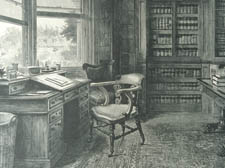| |

A sketch of the desk and chair shortly after the death of Charles Dickens |
Dickens’ desk Writer furniture on show
A GENUINE piece of literary history, from this desk and chair came the magical characters of Great Expectations, such as the terrifying Magwitch, searching the marshes for a file for his shackles, and the tragically agoraphobic Miss Havisham.
Also born on this hunk of mahogany and oak was Sydney Carton and the rest of the doomed protagonists of A Tale Of Two Cities, the story of guilt and guillotines said to be the most printed British novel of all time.
No wonder admirers of author Charles Dickens see much more than office furniture.
And now, after 20 years locked away behind closed doors, the desk where Dickens wrote his final three novels – Great Expectations, Two Cities and Our Mutual Friend – and the unfinished The Mystery of Edwin Drood, is on public view at last.
Irish millionaire owner Tom Higgins, who made some of his fortune running tarot reading phone-lines, loves Dickens so much he spent £433,250 on it at an auction last year, held to raise money for Great Ormond Street Hospital in Bloomsbury.
The desk had been passed through Dickens’s descendants before it was agreed that it could be used in the Great Ormond Street fund-raiser. The writer had been a founding patron of the children’s hospital.
For most of the time it is released from Mr Higgins’ home collection, it will be on display at the Dickens House Museum at 48 Doughty Street, Holborn, one of the writer’s former homes.
“In terms of Dickens artefacts, this is up there in the star category,” said Dr Florian Schweizer, a director at the museum.
Acquired by Dickens in 1859, the writing desk was a permanent fixture at Dickens’s final home in Gad’s Hill Place in Higham, Kent.
He actually sat at it thinking about what would have been the ending to Edwin Drood on the day he died from a stroke in June 1870, aged 58.
The desk was later the subject of an engraving and a painting by R.W. Buss.
Mr Higgins said: “The first time I visited the museum I was enthralled by the range of items on display and the magical time-shifting ambience they combine to create. So, obviously I am delighted to see the author’s desk go on display there.”
• |
 |
|
 |
| |
| |